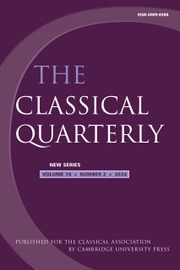Hecuba taunts the blinded Polymestor: ‘You will never put sight in your eyes.’ There is a similar expression in Pl. Resp. 518c τυφλοῖς ὀφθαλμοῖς ὄψιν ἐντιθέντϵς. But there the agent puts sight in another person’s eyes. More natural, for putting sight in one’s own eyes, would be the middle ἐνθήσῃ. Compare the middle in Ar. Eq. 51 ἐνθοῦ, ‘put (something) in one’s mouth’, as opposed to the active in 717, τῷ μὲν ὀλίγον ἐντίθης, ‘you put a little in his mouth’, the middle in Dem. 47.58 ἐνθϵμένης (sc. τὸ κυμβίον) ϵἰς τὸν κόλπον, ‘having put the cup in the fold of her dress’, as opposed to the active, of putting an object in another’s hands (Hes. Theog. 174–5, Eur. Alc. 854, Heracl. 727, fr. 857 Kannicht [= IA fr. dub. i Diggle]), and the middle in the epic expressions χόλον (κότον, μῦθον) ἔνθϵ(τ)ο θυμῷ (Il. 6.326, Od. 1.361, 11.102, 13.342, 21.355, 24.248). For this use of the middle, to bring the object of the verb into closer personal association with the subject, see Kühner–Gerth 1.103–7; E. Schwyzer, Griechische Grammatik 2.229–32; A.C. Moorhouse, The Syntax of Sophocles (Leiden, 1982), 177–8.
For the corruption of -ῃ to -ϵις (facilitated by the existence of the alternative second person middle and passive ending -ϵι)Footnote 1 see Eur. Alc. 157 θαυμάσῃ] -ϵις L, 1089 χηρϵύσῃ V: -σϵι BO: -ϵις L, Heracl. 652 προσθίξῃ Elmsley: -ϵις L, Phoen. 535 μαίνῃ] μένϵις MnS, 573 κατάρξῃ] -ϵις nonnulli, 1709 προθυμῇ] -ϵῖς Rf, Or. 1207 ἁμαρτήσῃ] -ϵις nonnulli, [Eur.] Rhes. 99 ὁπλίζῃ] -ϵις L, Soph. Aj. 369 ἐκνϵμῇ] -ϵις C: -ϵῖς D, Ant. 765 μαίνῃ] μένϵις uel μϵνϵῖς nonnulli, Phil. 752 ποῇ fere Jebb: πο(ι)ϵῖς codd.,Footnote 2 OC 1340 ξυμπαραστήσῃ] -ϵις plurimi, [Aesch.] PV 617 αἰτῇ] -ϵῖς Y.



